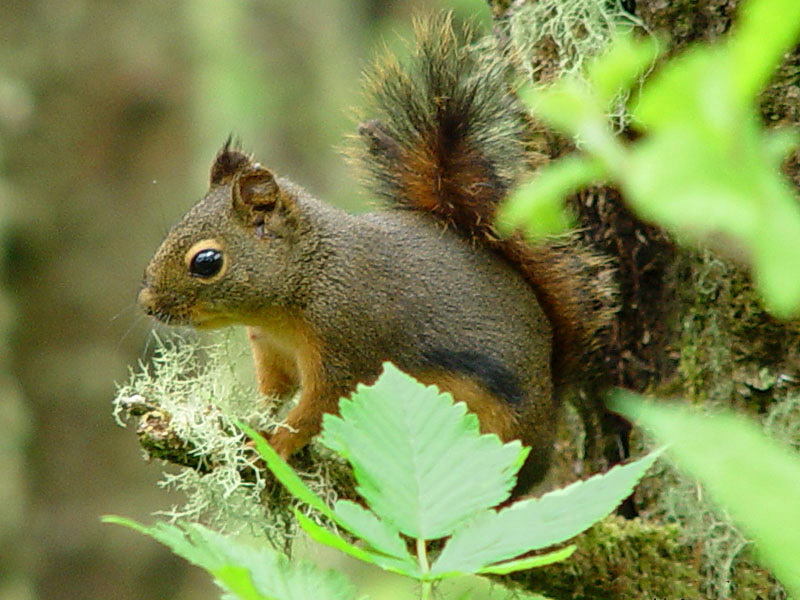Douglas Squirrel (Tamiasciurus douglasii) - wiki Douglas Squirrel
From Wikipedia, the free encyclopedia
[Photo] Tamiasciurus douglasii, Douglas Squirrel. Date July 09, 2003.
Location: Oregon Coast, Oregon. Photographer Franco Folini http://commons.wikimedia.org/wiki/User:Folini
The Douglas Squirrel, Tamiasciurus douglasii, is a pine squirrel found in the Pacific coastal states and provinces of North America. It is sometimes known as the Chickaree or Pine Squirrel, but since Chickaree is also used for the American Red Squirrel and Pine Squirrel for the genus Tamiasciurus, these alternative names are better avoided. The Native Americans of Kings River called it the "Pillillooeet", in imitation of its characteristic alarm call .
John Muir described the Douglas Squirrel as "by far the most interesting and influential of the California sciuridæ". It is a small, lively, bush-tailed tree squirrel, enchanting to watch. Adults are about 33 cm in length (including its tail, which is about 13 cm long), and weigh between 150 and 300 grams. Their appearance varies according to the season. In the summer, they are a grayish or almost greenish brown on their backs, and pale orange on the chest and belly, while legs and feet appear brown. In the winter, the coat is browner and the underside is grayer; also, the ears appear even tuftier than they do in summer. Like many squirrels, Douglas Squirrels have a white eye ring.
Douglas Squirrels live in coniferous forests, from the Sierra Nevada mountains of California northwards to coastal British Columbia. They prefer old-growth or mature second-growth forest, and some authors regard them as dependent on its presence. They are active by day, throughout the year, often chattering noisily at intruders. In summer nights, they sleep in ball-shaped nests that they make in the trees, but in the winter they use holes in trees as nests. They are territorial; in winter, each squirrel occupies a territory of about 10,000 square metres, but during the breeding season a mated pair will defend a single territory together. Groups of squirrels seen together during the summer are likely to be juveniles from a single litter.
Douglas squirrels mostly eat seeds of coniferous trees such as Douglas Fir, Sitka Spruce and Shore Pine, though they do also eat acorns, berries, mushrooms, the eggs of birds such as Yellow Warblers, and some fruit. Unlike many other types of tree squirrel, they lack cheek pouches in which to hold food. They are scatter hoarders, burying pine cones (which they cut from the trees while green) during the autumn. They often use a single place, called a midden, for peeling the scales off cones to get at the seeds. The discarded scales may accumulate for years, into piles more than a meter across as the same site is used by generations of squirrels. Their predators include American Martens, Bobcats, domestic cats, Northern Goshawks, and owls; although they quickly acclimatise to human presence, humans can be a threat to them, through robbing of their cone caches to find seeds for tree cultivation and through the destruction of old growth forest. However, the squirrels' numbers appear to be unaffected by commercial thinning of forests.
Mating can occur as early as February. Gestation is about four weeks, and the young (which are altricial) are weaned at about eight weeks of age. There may be up to six kits in a litter, though four is more usual. In the southern and lower parts of their range they produce two litters each year.
http://en.wikipedia.org/wiki/Douglas_Squirrel
| The text in this page is based on the copyrighted Wikipedia article shown in above URL. It is used under the GNU Free Documentation License. You may redistribute it, verbatim or modified, providing that you comply with the terms of the GFDL. |
